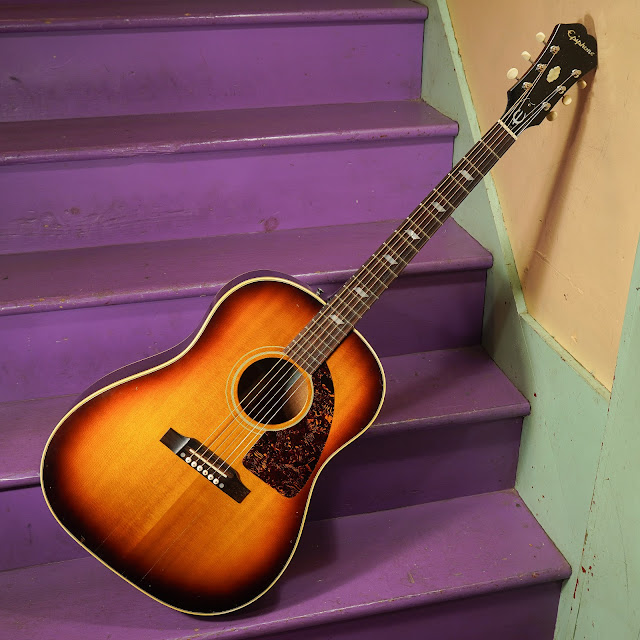1967 Epiphone FT79 Texan (Gibson-Made) Slope Dreadnought Guitar
The Gibson-made Epiphone Texan model of the '60s is a bit like the AJ of the '30s -- a slope dreadnought guitar with a longer scale length than the normal 24 5/8" or so of a same-period J-50 or J-45. It's also dressed-up a bit with a wider-pattern sunburst look and fancier inlays in the board. This one has the super-slick, narrow-nut neck of the mid-'60s Gibson products and it's a really nice "rock and roll chord-slinger" guitar because of that. For folks interested in fingerpicking, the tight spacing at the nut might be a deal-killer, however.
Tonally, it's a little punchier and more forward than a same-year J-45 but it has much of the plainspoken, woody, mids-centric voice of a J-45 despite that. I'm especially impressed with how much bass response this one has -- it's wide-sounding but not soupy or mushy at all.
Repairs included: a fret level/dress and setup. Previously, it's had hairline crack repairs and saddle work done and a hefty job repairing a headstock break near the nut, apparently. It's good to go,.
- Weight: 4 lbs 9 oz
- Scale length: 25 3/8"
- Nut width: 1 9/16"
- Neck shape: slim C/hair of U
- Board radius: 10"
- Body width: 16"
- Body depth: 4 7/8"
- Top wood: solid spruce
- Back & sides wood: solid mahogany
- Bracing type: x
- Bridge: rosewood
- Fretboard: rosewood
- Neck wood: mahogany
- Action height at 12th fret: 3/32” bass 1/16” treble (fast, spot-on)
- String gauges: 54w-12 lights
- Truss rod: adjustable
- Neck relief: straight
- Fret style: lower/wider
Condition notes: it has a couple of repaired hairline cracks on the lower bout below the bridge -- they're tight and good to go and hard to see. The original bridge saddle slot has been filled (for the adjustable saddle) and in its place a filler piece and bone saddle have been installed. It has an added strap button near the heel. The most significant issue with the guitar, however, is that the headstock has a pretty hefty repair running from under the first fret to into the headstock. It has a variety of spliced-in pieces to repair and reinforce the joint. It's stable, sturdy, and functional and has apparently been that way for some time. The guitar is otherwise mostly original with only the saddle, bridge pins, and nut as swaperoos. The finish shows light weather-check and mild wear and tear throughout, but mostly it looks grand.
It comes with: a good hard case.
Consignor tag: DCh






















Comments